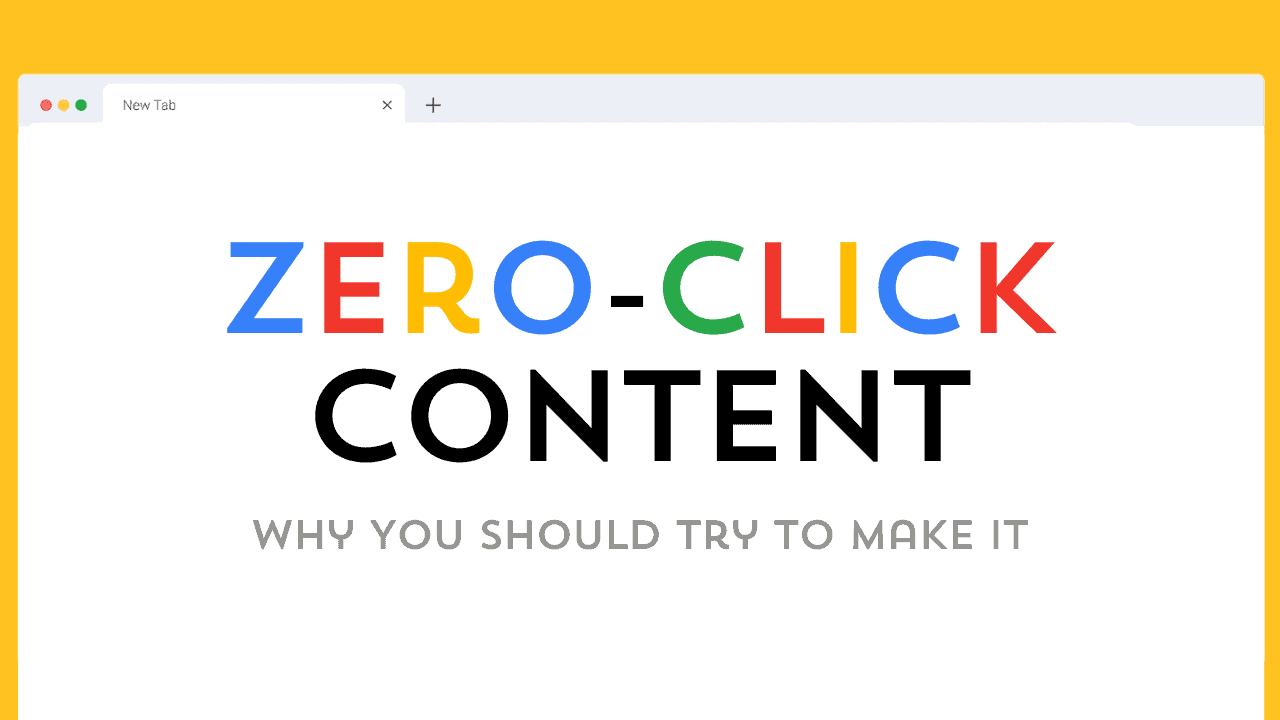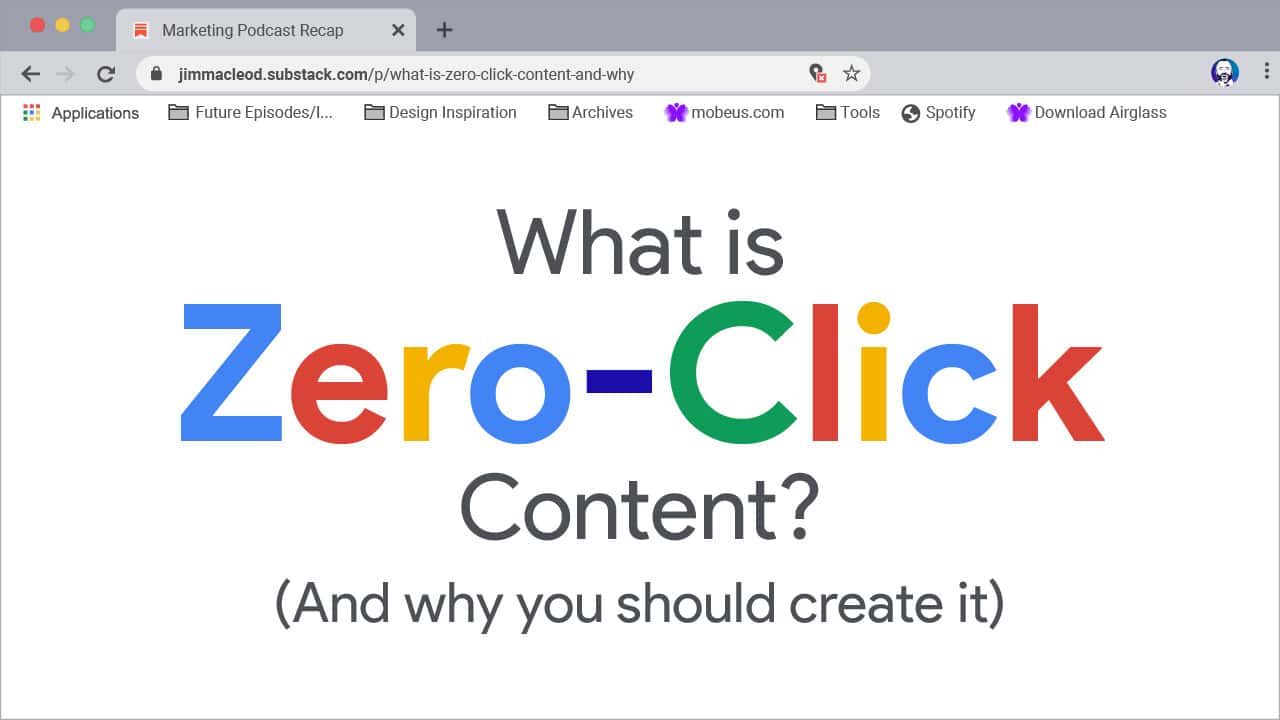Driving traffic through social media has always been challenging for marketers. External links are often disliked by platforms and algorithms, and users may not be eager to click on them. Fortunately, zero-click content might be the solution we’ve been looking for. Zero-click content aims to deliver immediate value and engage users with every post. Improved engagement can result in more followers, broader reach, enhanced brand sentiment, and increased chances of going viral. It’s a win-win-win for users, platforms, and brands. Although creating this content may demand more effort than simply sharing a link, we assure you it’s worth it. Below, we’ll outline the advantages of zero-click content and provide tips and examples to help you kickstart your journey.
What is zero-click content?
Zero-click content is information that gives value to users without requiring them to leave a platform.
Amanda Natividad, VP of Marketing at SparkToro, introduced this term in a blog post.
In Amanda’s words: “It provides valuable insights on its own — no need to click. Clicking can be optional, not necessary.”
The concept of zero-click content originated in digital marketing and SEO, where search engines display content within search engine results pages (SERPs). Users get answers without clicking through to a website by showing this content on the results page.
Zero-click search content can show up within a SERP as featured snippets, knowledge panels, video carousels, and more. These formats have evolved in recent years and will continue to change, keeping content marketers on their toes.
Here are some examples of this on social media:
- Threads with lists, stories, case studies, or step-by-step instructions.
- LinkedIn carousels with slides explaining a concept.
- YouTube Shorts, Snapchat, or TikTok videos teaching recipes, how-to guides, tutorials, etc.
- Instagram carousels with insights, data points, or key takeaways on each slide
- Bite-sized how-to videos work well as they teach short, easy-to-understand lessons many people can relate to.
Why create zero-click content?
Even though the term “zero-click content” is new, the idea isn’t.
At its core, zero-click content reflects a tried-and-true social media principle: create content that gives value to your users. After all, posting valuable content is more likely to gain you a follower, earn engagement, improve brand sentiment, and build a community.
Here are three reasons to build zero-click content into your social media marketing strategy.
Algorithms like zero-click content better
Most social media algorithms share one thing in common: wanting to keep users on the platform. This principle is evident on a platform like Instagram, which still doesn’t allow links in captions.
Platforms like Instagram, TikTok, and Snapchat have now made it possible to add external links. But, this doesn’t mean they like them—the algorithms still seem to favor posts without links. We conducted several experiments that showed linkless posts performed better on X and LinkedIn, and adding YouTube links to posts hurt their reach.
So, instead of trying to fight the algorithms, respect them. Create content that doesn’t need users to leave a platform. Not only will your zero-click posts perform better, but also the algorithms will reward your future posts.
Zero-click content benefits users
As a social media consumer, you already know this: we don’t love flipping between platforms. Most users resist clicking links because it requires effort and interrupts scrolling.
Because of this resistance, social media CTAs must be compelling to motivate users to open a link. That’s why algorithms have learned to favor zero-click content.
Human psychology and diminishing attention spans aside, zero-click content provides several benefits to users:
- Eliminates clickbait: No external links mean no creative headlines enticing users to click through.
- Guaranteed value: When posts reveal value upfront, users are more likely to read the thread or watch the video.
- More content in less time: Users can keep scrolling through their timeline instead of reading a long blog post.
In many ways, creating clickthrough content can be more complex than creating zero-click content. So, creating zero-click content is a win-win for users and brands.
Zero-click content can help build your social brand
The most successful brands on social aren’t simply posting links to their latest blogs. They’re giving the algorithms and their audiences what they want by creating content that offers value immediately instead of forcing people to click for more.
You need to trust that if you gift your audience with value, they’ll reward you with engagement. More engagement means more reach, which means more brand awareness and audience growth, which you can monetize. Posting valuable and engaging content can also improve your brand sentiment, and brand reputation, and grow your social community as more users engage with and share your posts.
It doesn’t mean every post you create has to be zero-click content. You can balance these posts with promotional content and external links. Perhaps zero-click content can be one of your content themes.
No matter what balance you choose, know that publishing zero-click content will benefit your brand.
8 tips for creating this content
Although making zero-click content involves more effort than sharing links, it can be great for engagement and audience-building.
Here are eight tips to help you create engaging and effective zero-click content.
1. Offer standalone value
Providing standalone value is the first and most important criterion when creating zero-click content. Good zero-click content teaches users something without needing to leave a platform.
When crafting zero-click content, ask these questions to ensure you’re providing standalone value:
- What are you trying to teach your audience?
- Keep basic storytelling principles in mind. Does it have a beginning, middle, and end?
- If this post came up in your FYP, would you learn something from it without visiting your website or consuming other content?
- Is it actionable?
2. Share the punchline upfront
Zero-click content is usually longer than a link-focused post. To compel users to read the full post, share the post’s value upfront to hook users’ attention.
My attention span is as fleeting as everyone else’s. If I see a piece of content and know I’ll get something out of it, I’m much more likely to stop scrolling.
Here are some tips for each post format:
- For carousels, put the payoff on the first slide
- For short-form videos, state the payoff in the first 3 seconds, the cover photo, and/or the caption
- For threads, include the payoff in the first post
3. Keep it short
When creating zero-click content, you want users to read the full post. Depending on the format, this means maximizing watch time, swiping through the whole carousel, or reading until the last post. In other words, your goal is to create bite-sized content that is only as long as it needs to be to share value.
Here are some guidelines on format lengths to help you create posts that strike the right balance between length and value:
- Short-form video (TikTok, Reels, Shorts): 60-90 seconds
- Post captions (Facebook, Instagram, X): 200-300 words
- Long-form videos (YouTube, etc.): 2-3 minutes
- Threaded posts (X): Up to 10 posts
- Carousels (LinkedIn, Instagram): 5-10 slides
4. Make it easy to read
Technically, this is a best practice for any social media content, but this principle is even more critical when the post is the content. Moreover, zero-click content has a slightly higher cognitive load than regular social content. You can lighten this load by making content as easy to read as possible.
Here are some tips:
- Use lists or bullet points instead of writing long paragraphs in threads or on carousel slides
- Incorporate clear and accessible design, using alt tags and following all social media accessibility guidelines
- Add a simple visual such as a graph or illustration, which can often convey value quicker than through words
- Don’t bury the lede—present the takeaway clearly and upfront (remember tip #2)
5. Repurpose a longer piece of content
Are you looking for inspiration for zero-click content? You don’t need to create brand new pieces each time—instead, look to your best-performing existing content for ideas.
Here are some ways to repurpose your long-form content:
- Take an excerpt from your podcast (and add visuals)
- Extract the three key takeaways from a video
- Pull the headlines and create an outline from a blog post or newsletter
- When repurposing long-form content, don’t just add a teaser.
- Remember, the point is to give away value in the post itself.
- You can still add a link to the original content piece—most likely, users will click through to read more details, see examples, or understand how it can apply to their business.
6. Use native features (and stay up-to-date)
Social media algorithms tend to favor posts that use native features, especially when they’re newly released. Because of this, creating zero-click content allows you to get creative with each platform’s post formats.
By using native features to create zero-click content, your posts will also stand out better in feeds. For example, early adopters of LinkedIn carousels earned 5x more clicks than other post formats.
Sadly, LinkedIn recently removed the carousel feature, but you still post them using this workaround.
So, my best tips in this case are to:
- Use native features as soon as they’re released
- Stay up-to-date on platform and feature changes
7. Use the right metrics to measure success
With zero-click content, marketers can’t use traditional social media KPIs like link clicks or conversions to gauge success. Instead, you’ll need to use different metrics, like—take a deep breath—reach and engagement. That’s right, I’m recommending you use so-called vanity metrics!
In this case, tracking your impressions (aka reach) and engagement per post will tell you how valuable they are to users. Using these metrics makes it easy to compare posts side-by-side and identify which zero-click posts resonate most with your audience.
8. Experiment
While I’m confident that zero-click content can work for any brand, there are still nuances about executing it well, depending on each brand’s audience.
The best way to figure out what will resonate? Run social media experiments. In a nutshell, create some hypotheses on what you think will work, and make at least five posts to test each hypothesis. Then, use your social media analytics to identify which content types performed better.
Even after you complete any experiments, continue to regularly check the performance of your zero-click content and adjust your formats and content pillars accordingly. As a social media marketer, you should always be experimenting.
How can I make zero-click content?
Craft social media posts that offer valuable information directly within the posts. Zero-click content should convey key takeaways or full context without requiring users to open a link.
How do I gauge the success?
To measure success, focus on impressions and engagement (likes, comments, shares, reposts). Brand lift can also indicate if your zero-click content is enhancing your brand’s reach and awareness.


